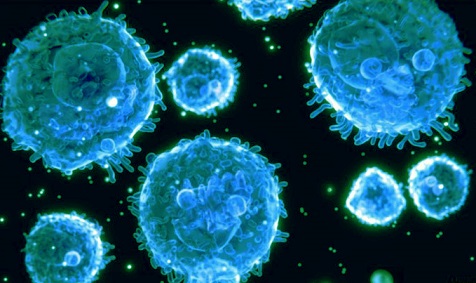Russian Study Finds That Immune-Regulating T Cell Subsets Show Delayed Recovery for a Year Following Acute COVID-19
Nikhil Prasad Fact checked by:Thailand Medical News Team Nov 01, 2024 5 months, 2 weeks, 3 days, 3 hours, 14 minutes ago
Medical News: COVID-19, the disease caused by the SARS-CoV-2 virus, affects millions globally, presenting symptoms from mild to severe. While the disease is known to cause significant respiratory distress and even multi-organ failure in severe cases, researchers have been examining the immune response during and after recovery. The latest study, led by scientists from Almazov National Medical Research Centre in Russia, takes a closer look at how specific immune cells, particularly T regulatory (Treg) cells, recover after COVID-19. This
Medical News report explains the importance of these cells in regulating immune responses and the discovery that, for many patients, their Treg cells do not return to normal levels for up to a year after the initial infection.
 Russian Study Finds That Immune-Regulating T Cell Subsets Show Delayed Recovery
Russian Study Finds That Immune-Regulating T Cell Subsets Show Delayed Recovery
for a Year Following Acute COVID-19
What Are Treg Cells and Why Are They Important?
T regulatory cells, commonly referred to as Tregs, are specialized cells in the immune system that help maintain balance. They prevent the immune system from attacking healthy cells and tissues, which helps avoid excessive inflammation and damage. This role is crucial in infections, like COVID-19, where inflammation can worsen the severity of symptoms. Tregs are categorized into several types, including “naïve” Tregs, central memory Tregs (CM), effector memory Tregs (EM), and terminally differentiated CD45RA+ effector cells (TEMRA). Each subset plays a different role in managing inflammation and ensuring immune balance.
Study Design and Key Findings
The research team analyzed blood samples from COVID-19 patients at various stages: during the acute infection phase, early recovery (3-6 months), and long-term recovery (6-12 months). By monitoring these samples over time, they aimed to understand how Treg cell counts and functionality change throughout recovery.
Acute Phase Changes
During acute COVID-19 infection, the study found a significant decrease in the total number of Tregs. Specifically, “naïve” Tregs and central memory Tregs showed the most pronounced decline. Researchers also noted a rise in effector memory Tregs, suggesting a shift in immune response that could be linked to the heightened inflammation seen in severe cases. These changes were consistent across patients with moderate and severe COVID-19 cases.
Early Recovery: Slow Increase in Treg Counts
Three to six months after the infection, the levels of Tregs began to improve, but they had not yet returned to the levels observed in healthy individuals. The “naïve” and central memory Tregs showed some recovery, while the effector memory Tregs remained elevated. Despite the gradual return of Treg cells, many patients still had lower Treg counts compared to healthy donors, which could have implications for their overall immune health.
Long-Ter
m Recovery: Full Restoration Still Out of Reach
After a year, the study discovered that while Treg levels had continued to improve, they still had not reached the levels seen in individuals who had never had COVID-19. This lingering reduction, especially in “naïve” and central memory Tregs, suggests that COVID-19 can leave a long-lasting impact on immune regulation. Additionally, while CD39 expression in all Treg subsets returned to normal, there was no significant change in CD73 expression. This detail hints at possible disruptions in immune cell function even after cell counts normalize.
What Do These Findings Mean?
This study offers critical insights into how the immune system recovers - or fails to recover - after COVID-19. A prolonged reduction in Treg cells could lead to a higher risk of chronic inflammation and other immune-related complications in patients who have had COVID-19, potentially explaining some of the symptoms associated with “long COVID.” By highlighting the delayed recovery of Treg cells, researchers emphasize the need for long-term monitoring of COVID-19 patients, even after they have recovered from their initial symptoms.
Conclusion
The study's findings reveal that COVID-19 has a lasting impact on the immune system, with certain Treg cell subsets not fully restoring even a year after infection. This delay in immune recovery could contribute to the lingering symptoms observed in long COVID cases. As the world continues to navigate the post-pandemic landscape, these insights could inform future treatments and monitoring strategies for those affected by COVID-19. Understanding these lingering immune changes is essential for developing therapies that can aid in full recovery.
The study findings were published in the peer-reviewed International Journal of Molecular Sciences.
https://www.mdpi.com/1422-0067/25/21/11759
For the latest COVID-19 News, keep on logging to Thailand
Medical News.
Read Also:
https://www.thailandmedical.news/news/t-cell-dysregulation,-uncoordinated-adaptive-immune-response-to-sars-cov-2-are-among-the-many-factors-behind-long-covid
https://www.thailandmedical.news/news/deciphering-the-mysteries-of-post-covid-immunity-unique-molecular-signatures-in-monocytes-and-regulatory-t-cells
